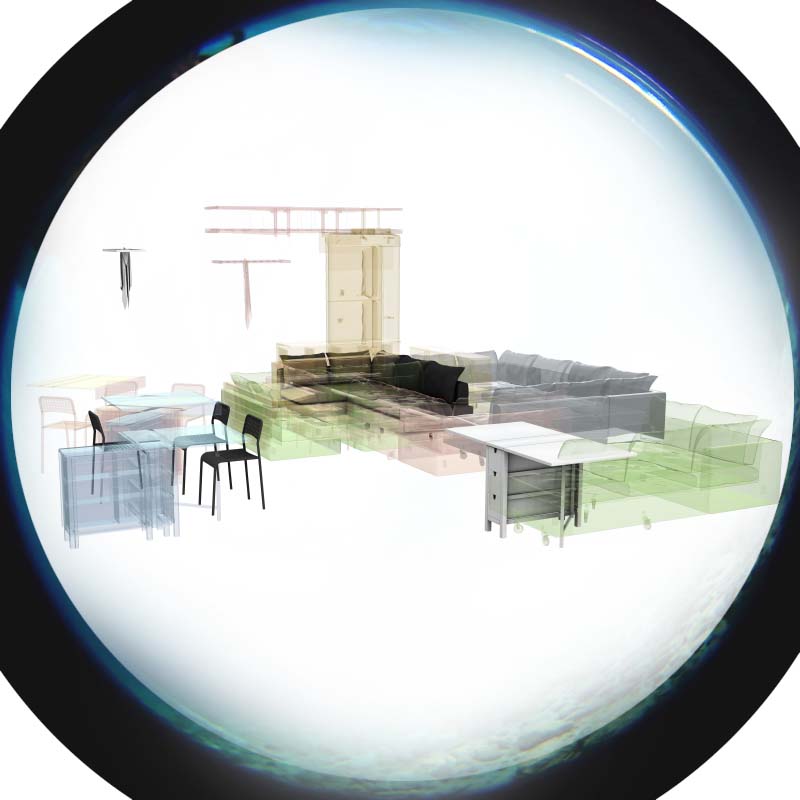

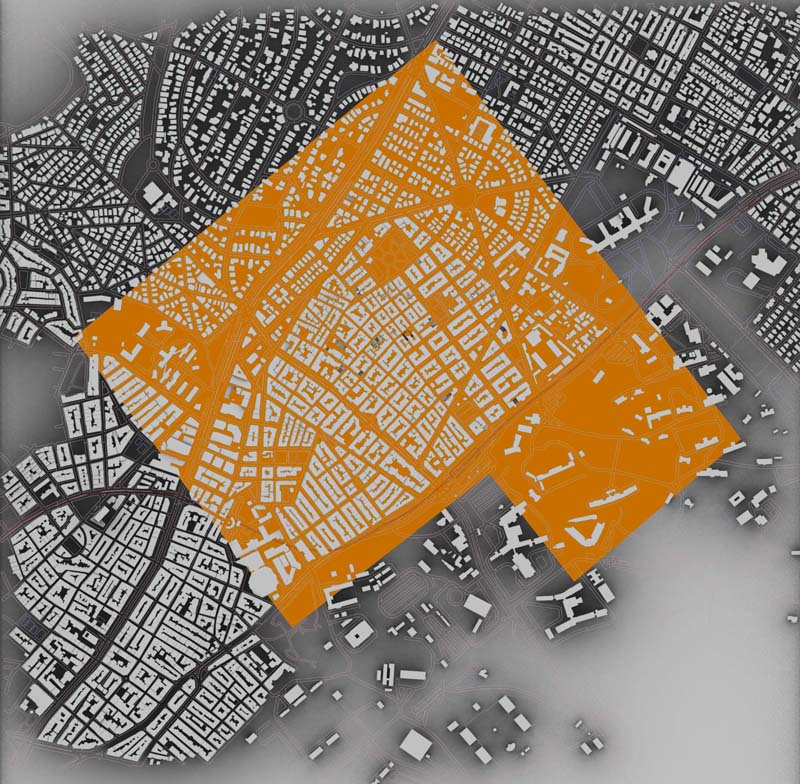

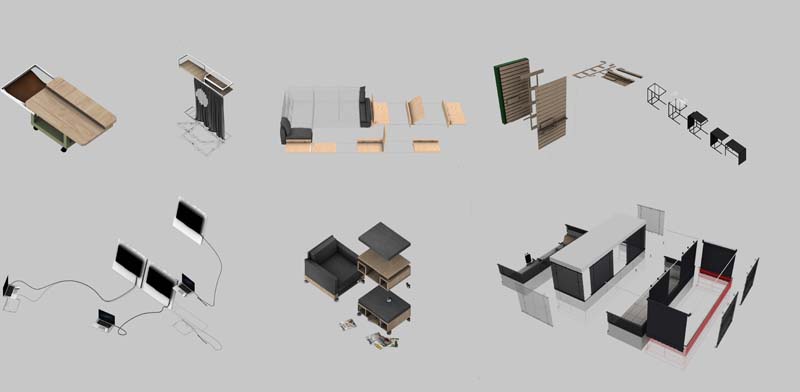

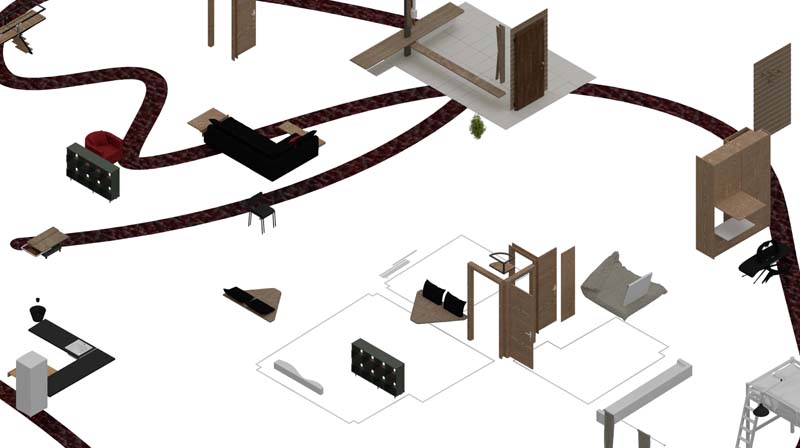

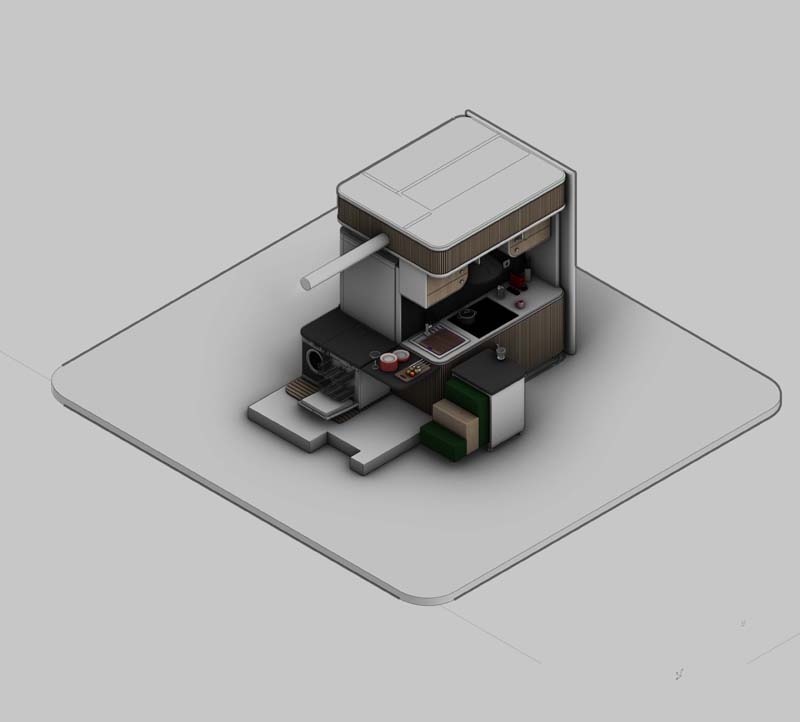

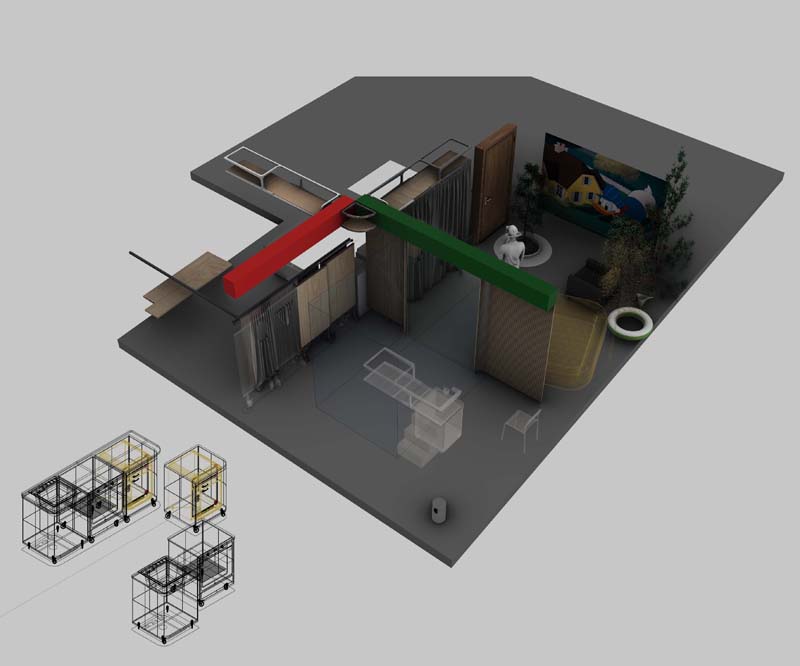

The bachelor’s thesis renegotiates the way of life in the modern apartment. The constantly new needs of their increasingly demanding users as well as the evolution of technologies that redefine habitation. But the imposition of a sudden confinement comes to contribute to the distance of man from his social environment and the city in which we live. The experience of the space becomes suffocating or even anti-productive since we have to work from there. The investigation through the interventions-constructions from the small scale (objects-furniture) to the larger scale (structural elements) is carried out with reference point of my apartment. The idea of an apartment inside the apartment itself creates the dialogue of the “inside” with the “outside” in the apartment itself helping work, relaxation, relaxation of activities and new ways of hospitality. Fragmenting the filling elements outside the bearing body and separating the free time from the productive one but also leaving the possibility open to the user who is constantly connected to the house to be disconnected from it, mutating the furniture. A multi-level space emerges that is free to be developed to meet the needs of the user. In the context of the previous analysis, you propose a prefabricated shell (capsule) that integrates the uses of the kitchen and bathroom to release passages for the flow of furniture movements, separating the apartment from the completely private to private-public. A basic tool for the production of space is the experiential observation of the possible positions of the objects, integration and appropriation of the furniture 1-1 and under what conditions they will take their final form. Perhaps the “undefined space” that Georges Perec could not perceive and called it useless_a-functional space. Contributing (and) his reflection, solutions are given for a more extended quality life in the modern Athenian district.
Supervisor: Mitroulias Giorgos
Reference Number: 845
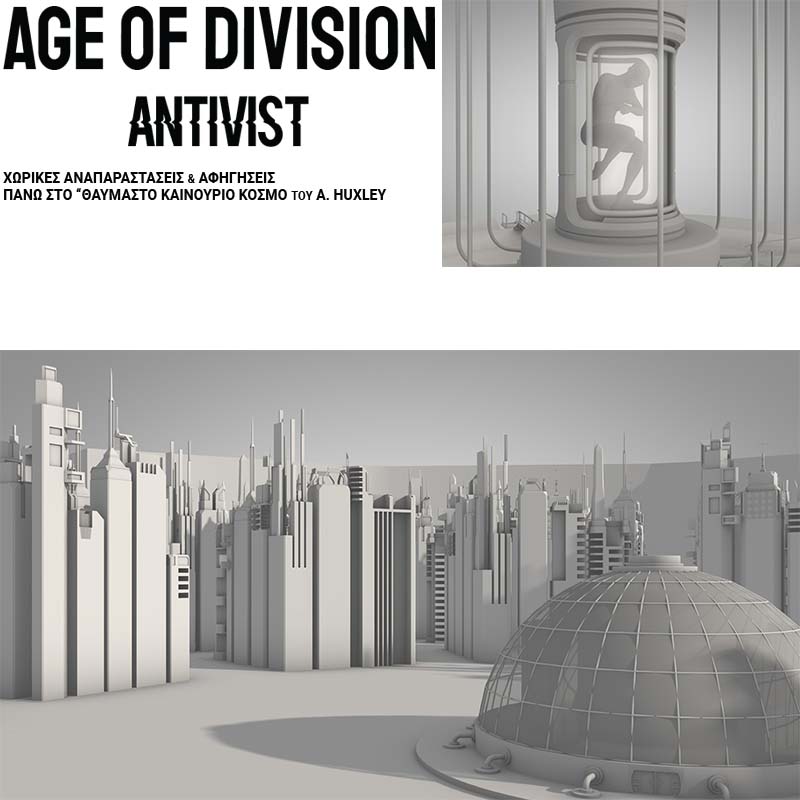

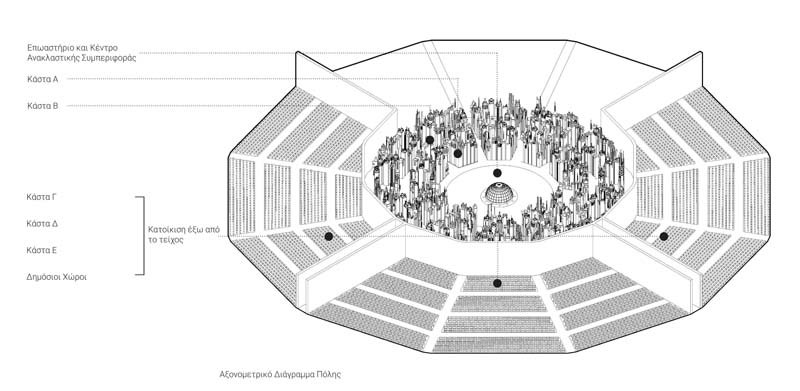

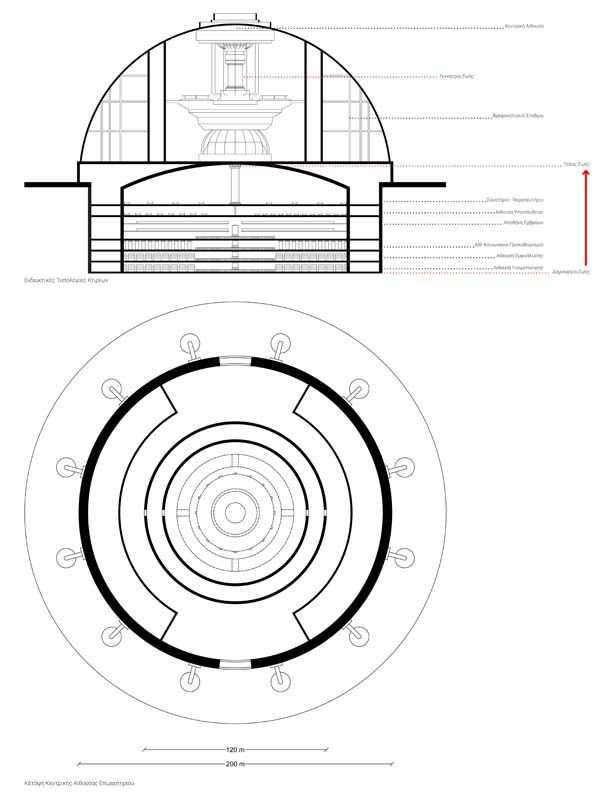

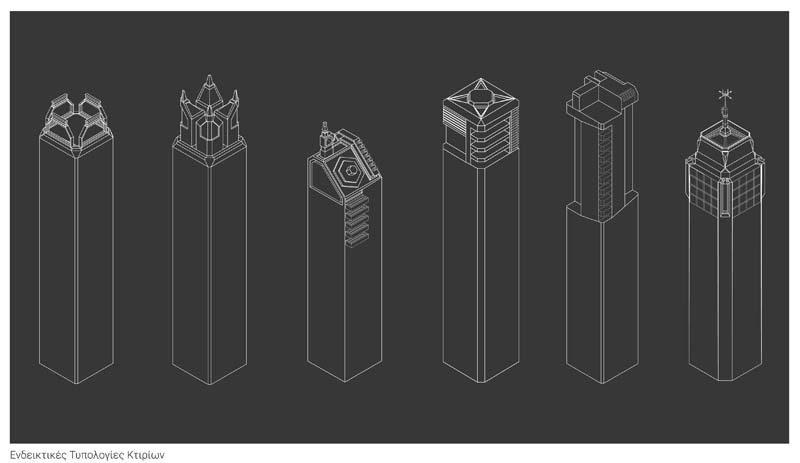

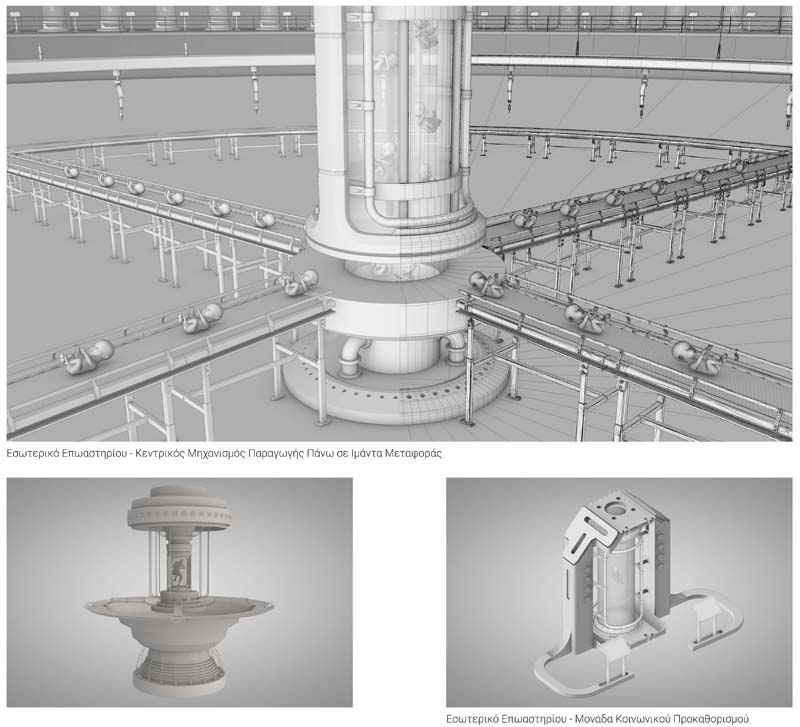

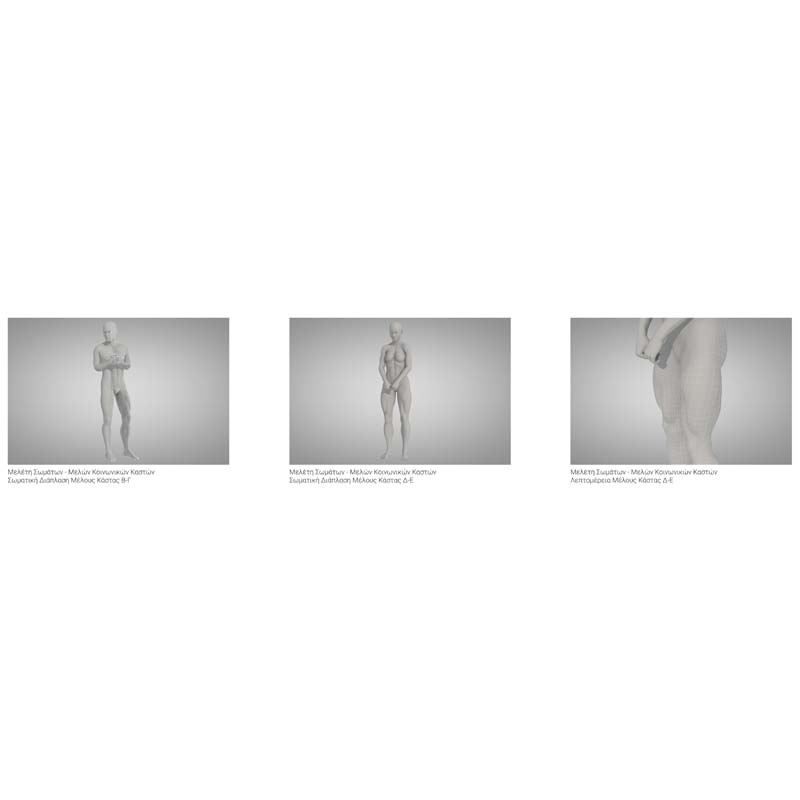

“Brave New World” is a dystopian novel written by Aldous Huxley in 1931, published in 1932. It describes primarily a futuristic World State whose citizens are environmentally designed and classified through social hierarchy based on the levels of intelligence. In contrast to many popular optimistic and/or utopian novels of the time, his intentions were to offer a terrifying look as long as visions of the future are concerned. He referred to the content of the book as a “negative utopia” which deals with issues such as corporate tyranny, the pre-determination of social behavior, as well as manipulation.
Based on the above, there is a need of further analysis regarding the organization of such a society, the spaces that it produces and how they host the share of people who make it up. Thus, a scenario emerged in which the spaces of this world are represented as they must serve each member of society separately, the points of integration and exclusion according to organized social castes and the procedures that define the beginning and the end of life. How would a society function as a result of developed genetic engineering? What are the instruments that make up the mechanism of life production and what is their symbolic and literal purpose? Finally, what is the position of the socially superior and how does they decide to act when the systems that favors them the most biologically and politically is in the verge of collapsing?
Supervisor: Papadopoulos Spiros
Reference Number: 797


The site of this thesis is placed in the city of Tampere in Finland and specifically in the area named Kaleva. The old Domus is a building complex that consists of five buildings that were constructed between the period 1959-1965 to function as student dormitories. The location of the site is ideal for student apartments because it is in a close proximity to the University of Tampere and 90 meters from the main road named Sammonkatu, where the main services of the area are located. The purpose of this dissertation is to reconstruct these buildings in order to increase student comfort, by maintaining as much as possible the structures of the buildings that already exist on the plot. The program, which was partly based on the data provided by the architectural competition held by the Tampere student housing foundation, aims to develop the plot by creating more functions in order to increase the sense of community and to facilitate the daily lives of the students. An equally important condition in the design of the structure, was the preservation of the cultural values of the area, since the site is located in the border of an area with cultural importance, and the creation of a connection between the old and the new Domus. The new architectural proposal comes to respect the already existing infrastructure and to take advantage of it in the best way possible in order to create more shared spaces, thus strengthening the relationships of the students and increasing the activities within the plot. The reconstruction isn’t limited to the restoration of the buildings, but offers new uses for the inner courtyard, while in addition, a raised collective garden is created that resonates with the ground floor and offers relaxation and activities to the members of the community. The purpose of the new plan isn’t the complete demolition of the existing building complex, but the completion and removal of some elements so as to create a more contemporary and functional set of buildings. The design is based on simple principles of bioclimatic design and it offers a number of small interventions that use the bioclimatic possibilities of the buildings and the environment. This new solution comes to show how we can give new life to an old building with simple architectural gestures.
Supervisor: Remy Nicolas
Reference Number: 816
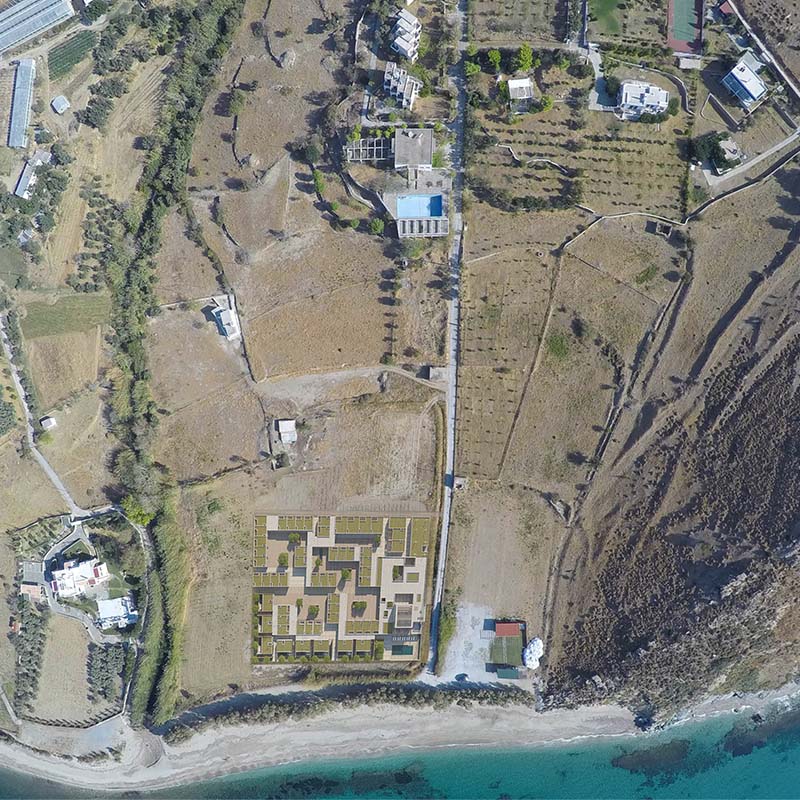

In the last decade, a significant development and growth has taken place in Greece in terms of the creation and production of wind energy parks. South Evia has the largest percentage of wind farms in Greece.Specifically, the area of Karystos has a very rich wind potential and has the appropriate specifications and weather conditions for their production. For the last ten years, wind energy parks are being created with a much larger number of wind turbines, while before the number of windenergy parks was very small in the area. This implies the arrival of a very large number of workers in Karystos. Due to the large number of RES workers, a significant problem has arisen in the area in terms of housing. In addition to the inability to accommodate all employees, there were also no proper standards to meet their needs, which created a problem for the hotel units where they lived. On the occasion of this specific problem and the continuous arrivals of RES, the initial impetus was created for this diploma project, which was the creation of a housing that would target this specific group of people, while strengthening the tourism sector in Karystos. Specifically, our goal was a housing that would serve the needs of the workers, where the spaces for which they can be reused in the context of tourism. Therefore, EN-Resort, reflects the combination of tourism and work, utilizing every need of the individual and the employee, in an environment where functions are not separated, but coexist with the existence of public functions and common green spaces.
Supervisor: Manolidis Kostas
Reference Number: 812
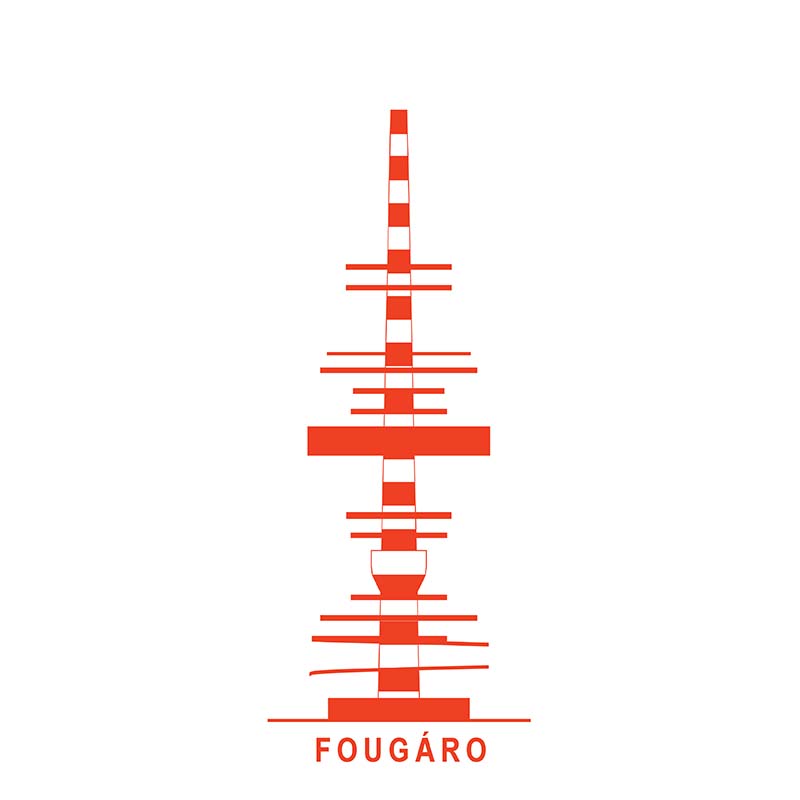

This thesis project was inspired by my case study about the balconies of Athens and the fact that they consist a key component on the configuration of the character of the city. Trying to answer personal questions about the mmultidimensional contemn porary identity of the Attic landscape leads to a research that ends up in the fact that the double balcony-hill, consists one of the basic elements that composes the Attic landscape. At the same time, a series of simultaneous events in Greece, have a strong influence on the way that this thesis project continues. The presentation of the idea for the new skyscrapers on the coastal area of Attica, in Ellinikon and the discussion about whether they are related to the identity of Athens is one of them. A few months later, the outbreak of the Covid-19 pandemic brought teleworking to the forefront and emptied office buildings for a long time. The use of a building as a working space is often attributed to tall buildings. After a research on the tall buildings of Athens, the buildings-hills as we define them in this project, we are led to the realization that they follow a specific pattern. These are buildings that are used as office spaces, and they never have balconies.
Thus arises the idea of a hill-building that renegotiates the form and program of the existing tall buildings of Athens and experiments with the attempt to include the character of the urban balcony in a public outdoor tall building. At the same time, the proposal comments the skyscrapers of Ellinikon, and after a series of urban analises and studies, we decide to locate it on the West coastal area of Attica, at Lipasmaton complex in Drapetsona.
The 118 meters high preserved industrial chimney, is the core around which a tall building that consists of balconies, is being developed. The new landmark does not have the intention to impose itself by creating new conditions forced in the place where it is located. On the contrary, it tries to interpret the special character of the site and in this way, to attract the citizens of Athens. Finally, the proposal leads us to reconsider the terms and parameters of the tall buildings construction in Athens.
Supervisor: Mitroulias Giorgos
Reference Number: 835
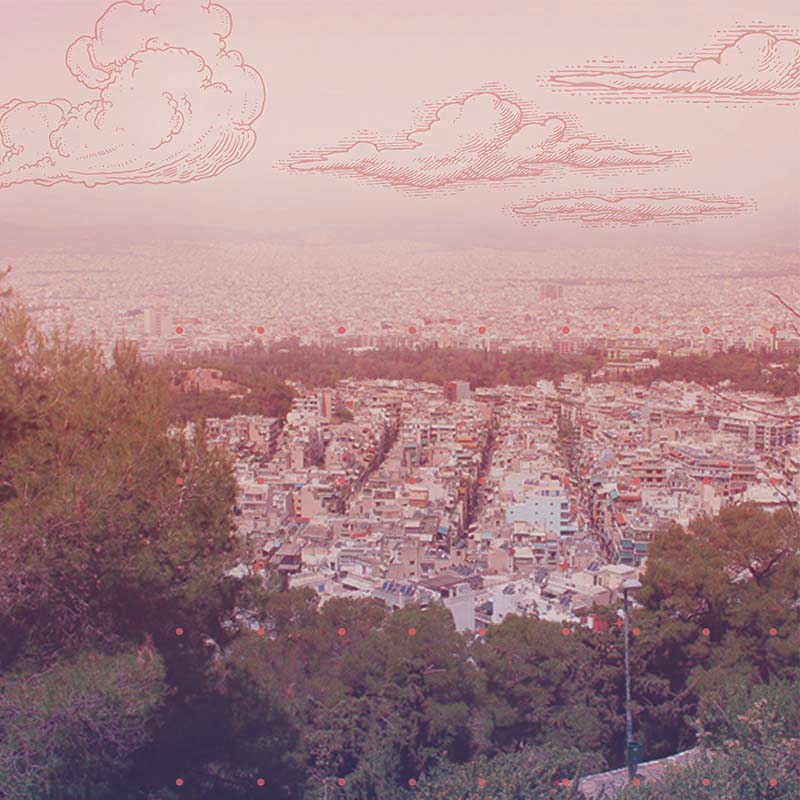

The occasion for the present work entitled "Locus Amoenus: A wandering on the Hill of Nymphs", was a series of personal stimuli and a strong interest in erotic architecture, the imagery of the erotic and romantic landscape, but also the relationship of architecture with desire in a more broad context, which are analysed in detail below. The choice of the Latin term Locus Amoenus in the title was based on the ambiguous content of the two words, as they indicate the character of the project. The term "locus" means place, location, point, hill. On the other hand the term "amoenus" that accompanies and characterizes it, means "idyllic, pleasant" and consists of three basic elements: trees, grass, water or some association of idyllic islands and is sometimes associated with the Garden of Eden. But what is Locus Amoenus and what are its characteristics that shape the identity of a modern urban landscape? To what extent is this place related to desire and the architecture of desire?
Lycabettus is not just any hill in the capital, nor is it just a green space. It is a place with a mythological and cultural dimension, something very important for its identity, while it is the dominant urban forest of the city centre. It is the "eye of the city" that offers enjoyment of the panoramic view, something that makes it an "emblematic landmark" of local and supra-local importance. In other words, it is the place where man escapes from everyday life and becomes his refuge. The elements that compose it, such as paths, maze, forests, caves, enhance the idyllic and bucolic landscape that has a positive effect on the mental health of man. Thus, the hill is transformed into a modern urban "locus amoenus" of an exquisite and ideal place where the erotic desire and the desire of the walker for sighting and wandering are manifested.
Supervisor: Mitroulias Giorgos
Reference Number: 827


Nowadays, an Educational Center for Astronomy is not a luxury for a big city like Volos with a rich cultural tradition. In the most developed countries, the Public Astronomy Centers and Observatories are much more widespread, and are engaged in research, education, training and employment of both students and young people as well as older people, as well as beauty and mysteries of the starry sky always fascinate and attract human interest.
This project deals with the creation of an Astronomy and Sky Observation Education Center in Agios Stefanos of Volos, aiming at disseminating and popularizing scientific and astronomical knowledge mainly to students, but also to the general public of Magnesia and Greece in general and as a building the program is structured arounf the perimeter of an open-air observatory as it is the main function of the building along with the main observatory and planetarium.
The building is located on the hill “Stavros” in Agios Stefanos, eleven kilometers from the city center of Volos. Since it is a center dedicated to observation and study of the sky, it was placed at the top pf the hill, which formed the basis of the synthetic idea and the relief of the hill together with the contour lines formed the boundaries of the building. A characteristic element of the building are the curved walls of reinforced concrete that can be seen from the open-air observatory and the canopy of the planetarium in the entrance of the building that is located outside and comes to break the circular shape. These synthetic elements in combination with the domes of the two observatories and the curved roof give the visitor the feeling that he travels in space.
Supervisor: Stylidis Iordanis
Reference Number: 824




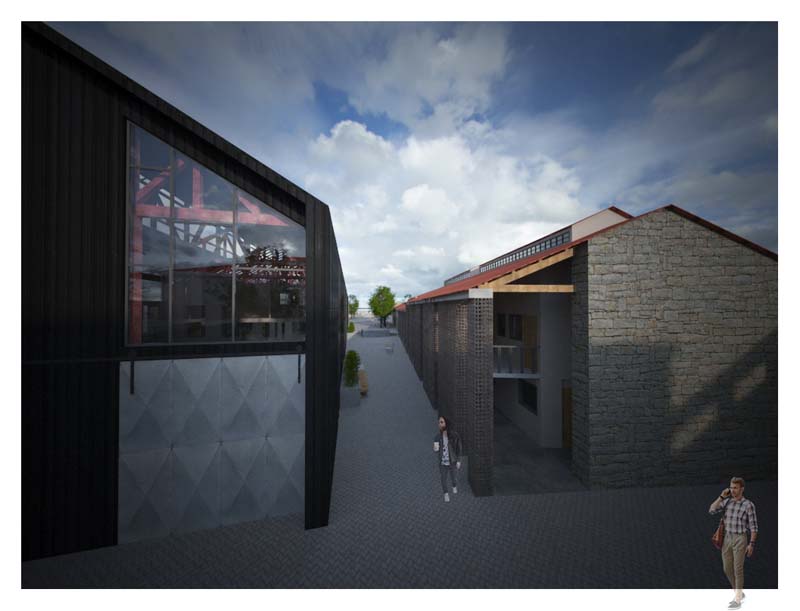



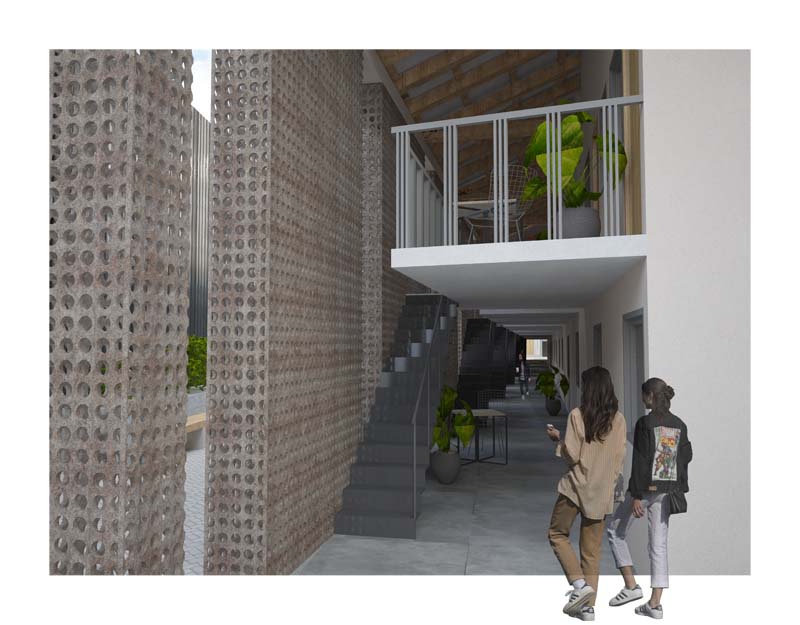

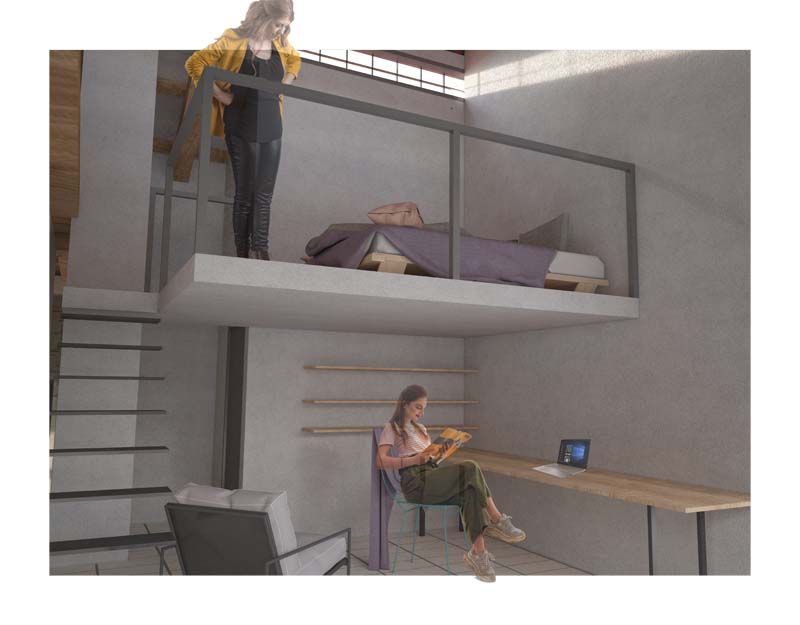

On the occasion of our experiential relationship with the city of Volos and discovering the various abandoned industrial buildings, we decided to reuse one of them. We chose the former industrial company Glavani, which is located on Papadiamanti Street parallel to the train lines. The starting point of the present diplomacy is the design creation of a space, with the basic element of the coexistence of seemingly heterogeneous functions, the synergy of which gives an original form. Thus, this proposal consists mainly of a department of industrial interest, a department of education and a department of housing. The idea of RE_UTH concerns the symbiotic process of a private and public operator and the revival of local industrial development, with as interactive and educational a character as possible. Thus, we propose the creation of a supplement of the University of Thessaly, which is associated with the strengthening of its laboratory facilities and operates in parallel with the second basic operation, that of production. All active members of the University are offered two workshops, one for wood and one for metal constructions, which have a complete equipment with all the new technological means. Next, we present a production model where students will have the opportunity to take part in the production process, in the form of an internship. This will provide them with more business experience and expertise, as students they would not be able to acquire. In addition, the supplement has residential areas where students of the University of Thessaly or even some visitors of this and the production unit that exists in the complex, will live. The project is complemented by some secondary functions, which complete the user experience, such as a management and meeting building and a museum building, which presents the historical background of the Glavani Industrial Company. Specially designed outdoor spaces complete the idea and allow for artistic, educational and cultural activities as well as recreation. In conclusion, Re_uth is not primarily concerned with the renewal of building stocks but with their reactivation. The buildings designed are not just operating containers. They are described as spatial manifestations in which intense activity and mobility manage to successfully revive a piece of architecture heritage of the city.
Supervisor: Mitroulias Giorgos
Reference Number: 801

